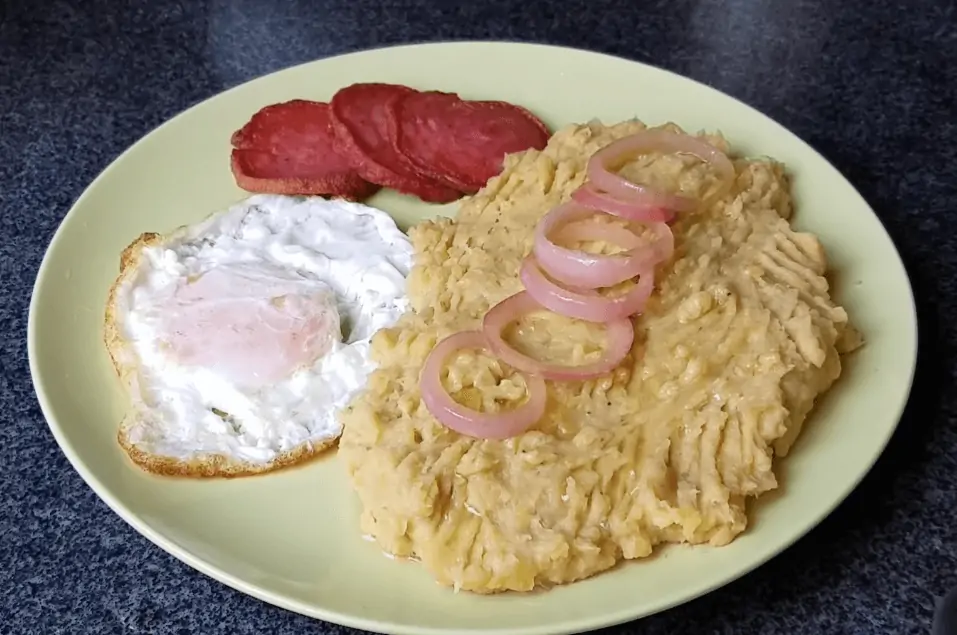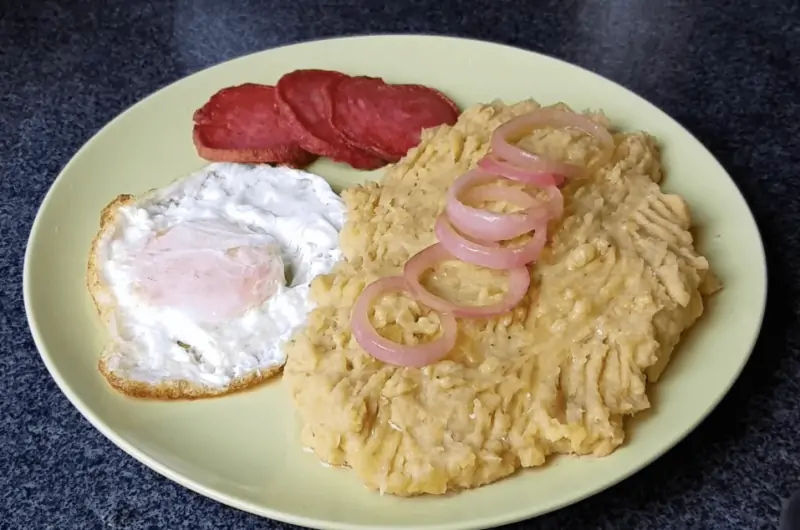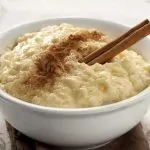The Best Fluffy Pancakes recipe you will fall in love with. Full of tips and tricks to help you make the best pancakes.
Mangu Dominicano, a traditional Dominican dish, holds a special place in the hearts and homes of Dominicans worldwide. This delightful mash of plantains, seasoned to perfection, has become a symbol of Dominican culture and a favorite comfort food for many. In this article, we’ll explore the history, ingredients, preparation, serving suggestions and more of Mangu Dominicano, inviting you to embark on a culinary journey to the heart of the Dominican Republic.
Mangu Dominicano: A Taste of Dominican Culture

Table of Contents
What is Mangu Dominicano
Mangu Dominicano is a traditional Dominican dish that holds cultural significance and is celebrated for its simplicity and rich flavors. At its core, Mangu is a mashed concoction made primarily from plantains, seasoned to perfection. The term “Mangu” itself stems from the Taino language, the indigenous people of the Dominican Republic, where it means “mashed.”
History
The roots of Mangu Dominicano delve into the rich history of the Dominican Republic. Originally born from the Taino people, the indigenous inhabitants of the island, Mangu has evolved over centuries through the influences of African and Spanish culinary traditions. What began as a simple sustenance food has transformed into a beloved cultural symbol, representing the resilience and adaptability of Dominican cuisine.
How to Make Mangu Dominicano
Ingredients:
- Ripe but firm plantains: 4
- Salt: To taste
- Water: As needed
- Optional:
- Onion (finely chopped): 1 small
- Vinegar: 1 tablespoon
- Oil (olive or vegetable): 2 tablespoons
Step by Step Instructions:
1. Peel and Cut the Plantains:
- Start by peeling the plantains and cutting them into even pieces. This ensures even cooking.
2. Boil the Plantains:
- Place the plantains in a pot of water and bring it to a boil.
- Boil until the plantains are tender; this usually takes around 15-20 minutes.
3. Mash the Plantains:
- Drain the water and mash the plantains until you achieve a smooth consistency.
4. Add Seasonings:
- Sprinkle a pinch of salt onto the mashed plantains.
- Optionally, add finely chopped onion for enhanced flavor.
5. Introduce Vinegar:
- For a subtle tanginess, add a tablespoon of vinegar to the mix. This adds a delightful contrast to the sweetness of the plantains.
6. Incorporate Oil:
- Add two tablespoons of oil (olive or vegetable) for richness. This step is optional but contributes to the overall flavor.
7. Mix Well:
- Ensure all ingredients are well combined, providing a uniform taste throughout.
8. Serve and Enjoy:
- Serve the Mangu Dominicano while still hot. It pairs well with traditional accompaniments like Queso Frito, Salami, or eggs.
Common Mistakes to Avoid:
- Overripe Plantains: Using overly ripe plantains can result in overly sweet Mangu. Choose ripe but firm plantains for the ideal balance.
- Inconsistent Boiling: Ensure even boiling to achieve a uniform texture. Inconsistencies may lead to lumps or unevenly mashed Mangu.
- Neglecting Seasoning: Proper seasoning is crucial. Don’t forget to add salt during the mashing process to enhance the overall taste.
- Skipping Optional Ingredients: While optional, ingredients like onion, vinegar, and oil add depth to the flavor profile. Don’t skip them if you want to elevate the dish.
- Rushing the Process: Take your time in each step. Rushing can lead to unevenly cooked plantains or a poorly mashed consistency. Patience is key for the perfect Mangu Dominicano.
How to Present
Presenting Mangu Dominicano is an art that enhances the dining experience. Follow these steps to create an appealing presentation:
- Mold it Artfully: Use a cup or a mold to shape the Mangu into a neat mound on the plate. This adds a touch of elegance.
- Garnish with Fresh Herbs: Sprinkle some fresh cilantro or parsley on top for a burst of color and a hint of herbal freshness.
- Drizzle with Olive Oil: A light drizzle of extra virgin olive oil not only enhances the flavor but also adds a glossy finish to your Mangu.
- Plate with Precision: Pay attention to the arrangement on the plate. Consider placing any accompanying items like Queso Frito or Salami strategically for a visually appealing dish.
How to Eat
Eating Mangu Dominicano is a delightful experience that combines flavors and textures. Here’s how to savor each bite:
- Use a Fork and Knife: Mangu is typically enjoyed with a fork and knife to cut through its velvety texture and any accompanying ingredients.
- Mix and Match: Combine each forkful of Mangu with the accompanying items like Queso Frito, Salami, or eggs. The combination of flavors creates a harmonious taste.
- Savor the Layers: Appreciate the layers of flavor – the subtle sweetness of the plantains, the savory notes of the accompaniments, and any additional richness from optional ingredients.
- Enjoy the Contrasts: Embrace the contrasts in textures, from the smoothness of the Mangu to the crispiness of Queso Frito or the savory bite of Salami.
Serving Suggestions
Elevate your Mangu experience with thoughtful serving suggestions:
- Breakfast Spread: Serve Mangu as the star of a Dominican breakfast spread. Include coffee, fresh fruit, and a variety of accompaniments for a wholesome morning meal.
- Brunch Buffet: If hosting a brunch, create a buffet with Mangu, different cheeses, cold cuts, and assorted tropical fruits. Let guests build their own Mangu masterpiece.
- Tapas-Style Sharing: Serve smaller portions of Mangu tapas-style with toothpicks, allowing guests to enjoy the dish in a social, sharing setting.
- Fusion Flair: Experiment with fusion by serving Mangu alongside dishes from other cuisines. It pairs surprisingly well with various international flavors.
Storage Instructions
Preserving the flavors and textures of Mangu requires proper storage. Follow these instructions:
- Refrigeration: Store any leftover Mangu in an airtight container in the refrigerator. Consume within 2-3 days for the best taste and texture.
- Freezing: While Mangu can be frozen, it may alter the texture slightly. Freeze in portions in airtight containers for up to one or two week.
- Reheating: When reheating, use a steamer or microwave for best results. Add a touch of water to maintain the desired consistency.
- Accompaniments: Store accompaniments like Queso Frito or Salami separately to prevent them from becoming soggy. Refrigerate according to their individual storage requirements.
Variations of Mangu Dominicano
The versatility of Mangu Dominicano allows for various regional and personal adaptations. Some notable variations include:
- Mangu de Queso: Incorporating cheese into the mashed plantains for a creamy and savory twist.
- Mangu con Los Tres Golpes: Served with three classic accompaniments – fried cheese, salami, and eggs.
- Mangu with Bacon: Infusing smoky bacon flavor into the dish for an indulgent variation.
Popularity of Mangu Dominicano
While Mangu Dominicano is a culinary gem rooted in the Dominican Republic, its popularity has transcended borders. The dish has gained recognition and love in various countries, including:
- United States: Particularly in areas with a significant Dominican diaspora.
- Spain: Influenced by the historical ties between the Dominican Republic and Spain.
- Puerto Rico: Given the shared cultural influences in the Caribbean.
- Cuba: Where similar variations of mashed plantains are enjoyed.
Health Benefits
Beyond its delectable taste, Mangu Dominicano brings several health benefits to the table:
- Rich in Nutrients: Plantains, the primary ingredient, are a powerhouse of vitamins and minerals, including potassium, vitamin A, and vitamin C.
- Sustained Energy: The carbohydrates in plantains provide a steady release of energy, making Mangu an excellent choice for a hearty and energizing meal.
- Dietary Fiber: Mangu offers a good dose of dietary fiber, aiding in digestion and promoting a healthy gut.
- Balanced Nutrition: When paired with protein-rich accompaniments like Queso Frito or eggs, Mangu becomes a well-rounded and satisfying meal.
- Cultural Connection: The emotional and cultural significance attached to Mangu contributes to its positive impact on mental well-being, fostering a sense of connection and nostalgia.
Conclusion
In conclusion, Mangu Dominicano transcends its culinary roots, embodying the rich history, cultural significance, and global appeal of Dominican cuisine. From its humble origins to modern-day innovations, Mangu continues to capture hearts and palates worldwide. As you embark on your Mangu-making journey, remember that this dish is more than a recipe – it’s a celebration of tradition, community, and the joy of shared meals.
FAQs
Can I customize the recipe to suit my taste preferences?
Absolutely! The beauty of Mangu lies in its versatility. Feel free to experiment with optional ingredients and adjust seasoning levels to match your personal palate.
What makes Mangu a comfort food for Dominicans?
Mangu is more than just a dish for Dominicans; it’s a connection to home, family, and the comforting flavors of childhood. Its familiar taste evokes a sense of nostalgia and warmth.
Are there any health benefits to eating Mangu Dominicano?
Yes, there are! Plantains, the main ingredient in Mangu, are a rich source of essential nutrients, contributing to overall well-being and providing sustained energy.
How has Mangu Dominicano gained popularity globally?
The global popularity of Mangu can be attributed to its unique flavors, cultural significance, and the influence of social media. As more people discover and share their love for Mangu, its popularity continues to grow.
Recipe
Mangu Dominicano Receta (Traditional Cooking Method)
Course: Breakfast, BrunchCuisine: DominicanDifficulty: Easy4
servings15
minutes20
minutes250
kcal65
gm2
gm3
gm4
gmIngredients
Ripe but firm plantains: 4
Salt: To taste
Water: As needed
Optional:
Onion (finely chopped): 1 small
Vinegar: 1 tablespoon
Oil (olive or vegetable): 2 tablespoons
Directions
- Peel and cut the plantains into even pieces.
- Place the plantains in a pot of water and bring to a boil.
- Cook until the plantains are tender.
- Drain the water and mash the plantains until smooth.
- Sprinkle a pinch of salt onto the mashed plantains.
- Optionally, add the finely chopped onion for enhanced flavor.
- Pour a tablespoon of vinegar into the mixture, providing a subtle tang.
- Add two tablespoons of oil (olive or vegetable) for richness.
- Ensure all ingredients are well mixed for an even distribution of flavors.
- Serve the enhanced Mangu Dominicano while still hot for the best taste.
Notes
- Tailor the amount of finely chopped onion to your preference for a more pronounced or subtle flavor.
- Try different oils such as olive or vegetable to discover unique taste variations.
- Explore various types of vinegar to add distinct tanginess to your Mangu.
- Choose ripe but firm plantains to strike the ideal balance between sweetness and starchiness.
- Adjust the salt levels according to your taste preferences.
- Enhance your Mangu experience by serving it with Queso Frito, Salami, or eggs.
- Experiment with boiling times to achieve your desired plantain texture.




